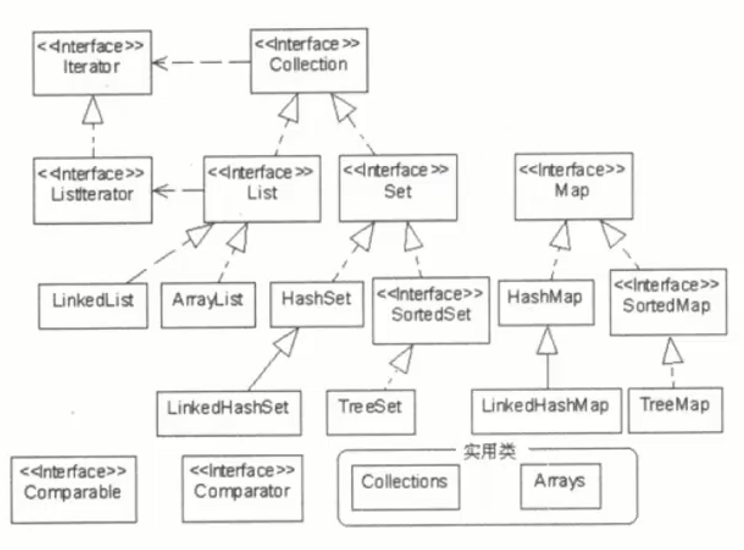1.类集Collection
1.1基本概念:类集就是一个动态的对象数组,是对一些实现好的数据结构进行了包装。
1.2主要接口
1)List:是Collection的子接口,对Collection进行了大量的扩充。允许内容重复。
2)Set:是Collection的子接口,没有对Collection进行扩充。不允许内容重复。
3)Map:是存放一对值得最大父接口,以ke-value的形式存放。
4)Iterator:集合的输出接口,只能进行从前到后的单项输出。
2.List
2.1常用子类:ArrayList
1)实例化
List<String> allList = new ArrayList<String>();2)扩展方法
//在指定位置增加元素
allList.add("qwer");
allList.add(0,"Hello");
//放回指定位置元素
allList.get(0);
//删除指定位置的元素
allList.remove(0);
//替换指定位置的元素
allList.set(0,"Hello");
//是否为空
allList.isEmpty();
//字符串是否存在
System.out.println(allList.contains("Hello")?"\"Hello\"存在":\"Hello\"不存在");
//集合截取
allList.subList(2,3) ;
//返回元素所在位置
allList.indexOf("Hello") ;3)输出内容
for(int i=0;i<allList.size();i++){
System.out.print(allList(i)+",");
}4)转换为对象数组
String str[] = allList.toArray(new String[]{});3.Set
3.1常用子类
1)HashSet:散列存放,不能重复,没有顺序。
2)TreeSet:对输入放入数据进行有序排列。
3.2实例
Set<String> allSet = new HashSet<String>();
SorteSet<String> sorteset = new TreeSet<String>();3.3TreeSet指定规则排序
public class TreeSetComparable {
public static void main(String args[]){
Set<Person> allSet = new TreeSet<Person>();
allSet.add(new Person("张三",25));
allSet.add(new Person("李四",24));
allSet.add(new Person("王五",29));
System.out.println(allSet);
}
}
//定义Person类,实现比较器
class Person implements Comparable<Person>{
private String name;
private Integer number;
public Person(String name,Integer number){
this.name=name;
this.number=number;
}
//覆写toString方法
public String toSting(){
return "姓名:"+this.name+"; 年龄:"+this.number;
}
//覆写compareTo方法
public int compareTo(Person person){
if (this.number>person.number){
return 1;
}
else if (this.number<person.number){
return -1;
}
else {
return 0;
}
}
}Iteration接口:迭代输出。
输入实例
import java.util.Iterator;
import java.util.Set; // Collection 的子接口
import java.util.HashSet; // Set 的实现类
class Test{
public static void main(String args[]){
System.out.println("<------- Iterator【迭代器】 讲解--------->");
//Iterator <-- Collection <-- Set <-- HashSet
// <-- List <-- ArrayList
//Iterator【迭代器】 :hasNext(); next();
//调用 Set 对象的 Iterator 方法,会生成一个迭代器对象,该对象用于遍历整个 Set
Set<Integer> itSet = new HashSet<Integer>();
itSet.add(1111);
itSet.add(2222);
itSet.add(3333);
itSet.add(1234);
Iterator<Integer> it = itSet.iterator();
while(it.hasNext()){
Integer i = it.next();
System.out.println(i);
}
}
}ListIterator:双向迭代输出。
foreach
输出格式
for(类 对象:集合){
//集合操作
}Enumeration:最早的迭代输出接口。
Map(键值对(key-value))HashMap:无序存放,Key不允许重复。
增加和取得内容
Map<String,String> map = new HashMap<String>();
map.put("qq","ww");
String val = map.get("qq");
String key = map.get("ww");判断指定内容是否存在
map.containsKey("qq"); //返回 true or false
map.containsVaule("ww")输出全部Key或者Value
Set<String> keys = map.Keyset(); //Set<String> values = map.value();
Iterator iter = keys.iterator();
While (iter.hashNext()){
String str = iter.next();
System.out.println();
}HashTable:旧操作类。
TreeMap:可以排序的Map集合,按照集合的Key排序,Key不允许重复。
WeakHashMap:弱引用的Map集合,当集合的某些内容不再使用时清楚掉无用的内容,使用gc进行回收。
IdentityHashMap:Key可以重复的Map集合。
Map输出
import java.util.Map;
import java.util.HashMap;
import java.util.Iterator;
import java.util.Set;
public class MapDome01 {
public static void main(String[] args){
Map<String,String> map = new HashMap<String,String>();
map.put("慕课","www.imooc.com");
map.put("百度","www.baidu.com");
map.put("谷歌","www.google");
// ---------Iteration输出
// Set<Map.Entry<String,String>> str = map.entrySet();
// Iterator<Map.Entry<String,String>> it = str.iterator();
// while (it.hasNext()){
// Map.Entry<String,String> qq = it.next();
// System.out.println("名称---》"+qq.getKey()+
// "网址---》" + qq.getValue());
// }
// -----foreach输出
for (Map.Entry<String,String> str:map.entrySet()){
System.out.println("名称---》"+str.getKey()+ "网址---》" + str.getValue());
}
}
}Map使用非系统类作为Key值
import java.util.Map;
import java.util.HashMap;
class Person1{
private String name;
private int age;
public Person1(String name,int age){
this.name = name;
this.age = age;
}
public String toString(){
return "名字:" + this.name + " 年龄:" + this.age;
}
}
public class MapDome01 {
public static void main(String[] args){
Person1 per = new Person1("袁艺",23);
Map<String,Person1> map = new HashMap<String,Person1>();
map.put("yuanyi",per);
System.out.println(map.get("yuanyi"));
}
}1)为集合增加内容
List<String> all = new ArrayList();
Collection.addAll(all,"11","22","33");2)反转集合中的内容
Collection.reverse(all); //内容反转保存3)检索内容
int point = Collection.binarySearch(all,"11"); //返回1
int point = Collection.binarySearch(all,"44"); //返回-1 4)替换集合中的内容
Collection.replaceAll(all,"11","00"); //输出结果 00 22 335)集合排序
Collection.sort(all);6)交换指定位置的内容
Collection.swap(all,0,2); //输出33 22 11Stack:栈是采取先进后出的数据存储方式。
Propertes:属性类。
1)设置和取得属性
Properties pro = new Properties
pro.setProperties("BJ","Beijing");
pro.setProperties("SH",Shanghai");2)将属性保存在普通文件中
File file = new File("D:"+File.separator+"area.properties"); //设置属性文件的储存的路径
pro.stor(new FileOutputStream(file),"Area Info"); //保存属性到普通文件中,并设置注释内容3)从属性文件内容中读取内容
pro.load(new FileInPutStream(file));
共同学习,写下你的评论
评论加载中...
作者其他优质文章





